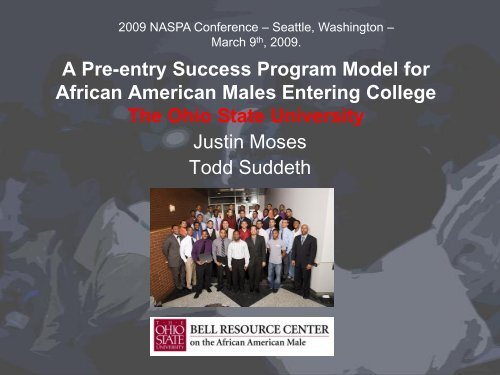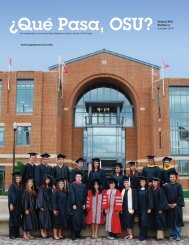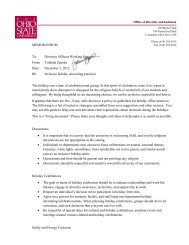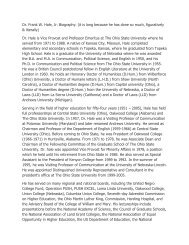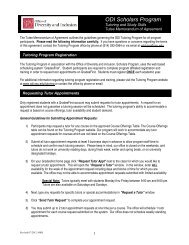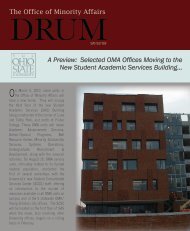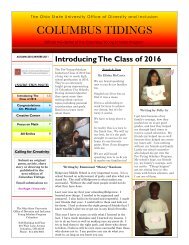A Pre-entry Success Program Model for African American Males ...
A Pre-entry Success Program Model for African American Males ...
A Pre-entry Success Program Model for African American Males ...
- No tags were found...
Create successful ePaper yourself
Turn your PDF publications into a flip-book with our unique Google optimized e-Paper software.
2009 NASPA Conference – Seattle, Washington –March 9 th , 2009.A <strong>Pre</strong>-<strong>entry</strong> <strong>Success</strong> <strong>Program</strong> <strong>Model</strong> <strong>for</strong><strong>African</strong> <strong>American</strong> <strong>Males</strong> Entering CollegeThe Ohio State UniversityJustin MosesTodd Suddeth
Purpose of presentation & discussion• <strong>Pre</strong>sent in<strong>for</strong>mation on the structure of the Bell ResourceCenter and the Office of Minority Affairs• Review literature concerning <strong>African</strong> <strong>American</strong> males incollege• Examine the structure and organization of the EarlyArrival <strong>Program</strong> <strong>for</strong> <strong>African</strong> <strong>American</strong> males at OSU• Discuss the impact pre-<strong>entry</strong> programs can have on<strong>African</strong> <strong>American</strong> males• Discuss the experiences of the various cohorts thatparticipated in Early Arrival <strong>Program</strong>.• Share ideas about the possibilities of similar programs atother universities and colleges.
Office of Minority AffairsPurpose• Provide leadership <strong>for</strong> The Ohio State University insupporting the success of minority students, faculty, andstaff• Emphasizes the recruitment, retention, and timelygraduation of undergraduate, graduate, and professionalstudents• Offers services including strategic programming,academic resources, and diversity development.
Office of Minority AffairsAcademic AffairsOffice ofMinority AffairsBell ResourceCenterAcademicAdvancementServicesMinorityScholarshipServicesHale BlackCulturalCenter<strong>Pre</strong>-Entry<strong>Program</strong>s
History and Developmentof the Bell Resource Center• 2002: National and local research studies conductedabout the per<strong>for</strong>mance of <strong>African</strong> <strong>American</strong> malestudents in college.• 2002 – 2003: Development of Black Male Initiative &other projects aimed at retention, matriculation, andgraduation of <strong>African</strong> <strong>American</strong> males.• 2004: Focus Group study on <strong>African</strong> <strong>American</strong> MaleExperience at OSU conducted by administrators, facultyand students
History and Developmentof the Bell Resource Center• 2004 – Office of Minority Affairs (OMA) approved <strong>for</strong>provisions and establishment of <strong>African</strong> <strong>American</strong> MaleResource Center (later named after Todd Bell).• <strong>Pre</strong>sent: – Office employees include the following:– Director– <strong>Program</strong> Director– <strong>Program</strong> Assistant– Graduate Students– Work Study Students– Doctoral Fellow
Todd Anthony Bell1958 - 2005• Ohio State Alum and <strong>for</strong>mer athlete <strong>for</strong> OSU• Former football player <strong>for</strong> the Chicago Bearsand Philadelphia Eagles• Bell returned to the University as Coordinator of <strong>for</strong> CommunityRelations in the Office of Minority Affairs• Instrumental in the Development of the Black Male initiative whichlater developed into the Bell Resource Center on the Africa<strong>American</strong> Male.• Under his leadership, initiatives <strong>for</strong> the success of <strong>African</strong> <strong>American</strong><strong>Males</strong> included:– Campus Engagement– Academic Achievement– Leadership Development
Bell Resource CenterMission Statement– To examine and address critical issues in society that impact the qualityof life <strong>for</strong> <strong>African</strong> <strong>American</strong> malesPriorities– Produce high-quality research and scholarship on <strong>African</strong> <strong>American</strong>males that in<strong>for</strong>ms theory, policy, and practice– Create a sense of community and connectedness <strong>for</strong> <strong>African</strong> <strong>American</strong>males at The Ohio State University to ensure their success in college– Identify best practices and apply cutting-edge research on <strong>African</strong><strong>American</strong> males– Provide consultation and professional development to school districts,colleges, agencies and other institutions on issues focusing on <strong>African</strong><strong>American</strong> males– Develop partnerships with school districts, colleges, agencies, and otherinstitutions that improve outcomes <strong>for</strong> <strong>African</strong> <strong>American</strong> males
Initiatives and <strong>Program</strong>sInitiativesMajor<strong>Program</strong>sOther ActivitiesResearch andEvaluationEarly Arrival<strong>Program</strong>AcademicMonitoringMen’s HealthInitiativeGathering of MenRoundtableDiscussion SeriesSouthmoor MiddleSchool<strong>African</strong> <strong>American</strong>Male RetreatHistorical LectureSeriesLeadershipInstituteRecognitionCeremonyProfessionalDevelopmentWorkshops
What the literature says about<strong>African</strong> <strong>American</strong> men in college:• Retention and recruitment ef<strong>for</strong>ts have increased andmore <strong>African</strong> <strong>American</strong> men are entering colleges anduniversities; however, drop-out rates are still consistentlyhigh (Seidman, 2005).– On going ef<strong>for</strong>ts to engage <strong>African</strong> <strong>American</strong> male studentsattendance must be consistent to ensure matriculation (Fortson,1997).• Engagement activities positively affects effects identitydevelopment and retention and graduationsrates(Cokley, 2001; Harper, 2004; Harper & Quaye,2007).– Activities include pre-collegiate programs and on-goingengagement activities throughout academic careers.
What the literature says about<strong>African</strong> <strong>American</strong> men in college• <strong>African</strong> <strong>American</strong> males must rely on each otherto persist through graduation (Cuyjet, 2006).– Intra-diversity within this group could complicaterelationships.– <strong>Program</strong>s inclusive of all <strong>African</strong> <strong>American</strong> men arebeneficial.• Supportive environments foster successfulacademic experiences and higher graduationrates (Palmer & Gassman, 2008).
What the literature says about<strong>African</strong> <strong>American</strong> men in college• <strong>Program</strong>s and policies concerning <strong>African</strong><strong>American</strong> men (and other specific studentpopulations) must yield identifiable outcomesand assessment (Hall & Rowan, 2001).– Continuity– Research– Legitimacy– Funding
The Need <strong>for</strong> an Early Arrival <strong>Program</strong>Lack of Skills• Academic <strong>Pre</strong>paration• Time/Personal Management• Study Skills(Light, 2004; Reid & Moore, 2008)Engagement and Supportive Relationships• Increase satisfaction with collegiate experience• Sense of belonging• Recognizing within-race diversity to build stronger relationships(Allen, 1987, 1988, 1992; Astin, 1993; Hurtado & Carter, 1997; Light, 2001; Martinez& Klopott, 2005; Strayhorn, 2008; Tinto, 1975; Upcraft et al., 1999)Stress• Racism, finances, and family (Allen & Danley, 2008; Cureton, 2003; Lett &Wright, 2003; Rowser, 1997)
The Need <strong>for</strong> an Early Arrival <strong>Program</strong>Correlation with Increased Retention Rates• Bridge programs compared to counseling, mentoring andprogramming (Patton, Morelon, Whitehead & Hossler,2006)Identity Development• Lack of self awareness credited with low persistencerates, (Cuyjet, 2006; Harper, 2004), especially at PWIsPsychological Impact• Impact decision-making process, perception, selfefficacy, internal locus of control, (Bean & Eaton, 2001)
Early Arrival <strong>Program</strong> PurposeIntroduction tothe UniversityExpectations<strong>for</strong> <strong>Success</strong>Early Arrival<strong>Program</strong>PracticalSkillsSocial BondingEngagementCampusResources
Early Arrival <strong>Program</strong> - ComponentsNew incoming first quarter studentsThemed <strong>Program</strong>sWeekend be<strong>for</strong>e the start of classes<strong>Pre</strong>sentation on services andresourcesMove into residence hall earlyWorkshops: academic success,personal, professional developmentExpenses covered: food & lodgingInteraction with alumni, faculty/staff,current students
Structure of <strong>Program</strong>DAY 1• Move-in/Registration• Introductory Session• Parents Session• Reflection Time• Faculty PanelFOLLOW UP• Participantsencouraged to utilizeresources at BRC• Participants encouragedto maintain contact withcenterDAY 2• Time Management• Student Panel• Academic <strong>Success</strong>• Resources Services• Campus TourDAY 3• Team Building• Career Planning• Student Engagement• Community Ethics• Closing Activity
Resources NeededFacultyStaffParticipationBudgetVolunteersEarlyArrival<strong>Program</strong>Departments- OMA Offices- Student Affairs- AcademicDepartments- External Agenciesand Individuals
RETENTION AND GRADUATION RATES –Freshman Entering between 2002 – 2007(by percentage) (cont.)MALE TOTAL2002 2003 2004 2005 2006 2007Total First Yr.RetentionWhite – NonHispanic87.5 88.0 89.5 91.7 92.9 93.188.1 89.0 89.6 92.6 93.2 93.5Hispanic81.9 88.9 85.5 88.8 89.4 90.8<strong>African</strong><strong>American</strong><strong>African</strong><strong>American</strong> EAPParticipants78.1 78.6 86.9 86.5 90.8 91.696% 96.2 93.8
Comparison between <strong>African</strong> <strong>American</strong> Female &Male First -Year Retention Rates1998 1999 2000 2001 2002<strong>Males</strong> 69.4 74.2 78.7 68.6 78.1Females 76.9 78.4 76.9 77.1 82.62003 2004 2005 2006 2007<strong>Males</strong> 78.6 86.9 86.5 90.8 91.6Females 82.0 88.8 90.6 88.4 90.3
Challenges• Maintaining contact after EAP• Rein<strong>for</strong>cement of skills and knowledgelearned• Millennial generation less engaged• Student cohort characteristics changefrom year to year
Assessment of EAP• Yearly focus groups <strong>for</strong> each cohort ofparticipants(Watkins, Green, Goodson, Guidry, & Stanley, 2007)– 8-10 students interviewed each winter to discuss theirexperience– Report generated from the results of focus group– Recommendations reviewed and incorporated <strong>for</strong>future Early Arrival <strong>Program</strong>s– Opportunity to learn from strategies students used topersist and be successful (June, Curry, & Gear,1990)
Responses from participants• “This is a great program! I suggest extending itto other minority groups as well.”• “Just being able to get other black malestudent's outlook on college life at OSU ishelpful.”• “I liked the brotherhood that I felt was <strong>for</strong>med bythis program among us young black men.”
Responses (Cont.)• “Each program had valuable in<strong>for</strong>mationthat I will more than likely utilizethroughout the academic year.”• “I greatly appreciate the warm welcomeand wise words offered by the men in thisprogram.”
Responses (Cont.)From:Sent: Thursday, September 25, 2008 12:32 PMTo: Suddeth, ToddSubject: Bell Resource programTodd,Hey this is Dag, just wanted to thank you <strong>for</strong> putting together the bellresource program. Only in my second day of classes I have usedmuch of what I learned in those three days. Just wanted to keep intouch and say thanks again.
Discussion• Do you have an earlyarrival program on yourcampus?• Is an early arrivalprogram a viable option<strong>for</strong> yourcollege/university?• What would be thechallenges?• Are there other studentpopulations that couldbenefit from a similarprogram?• Do you have theresources? Possiblecollaboration?• Could youreduce/increase thetime/scope of a similarprogram?
ReferencesBean, J. & Eaton, S. B. (2001). The psychology underlying successful retention practices. Journal of College StudentRetention, 3(1), pp. 73-89.Bean, J. (2006). Composing academic identities: <strong>African</strong>-<strong>American</strong> students as language researchers. InternationalJournal of Learning, 12(8), pp. 241-247.Clewell, B. C., & Ficklen, M. S. (1986). Improving minority retention in Higher Education: A search <strong>for</strong> effectiveinstitutional practices. Educational Testing Service, Princeton, N.J.Cokley, K. O. (2001). Gender differences among <strong>African</strong> <strong>American</strong> students in the impact of racial identity onacademic psychosocial development. Journal of College Student Development, 42, 480-487.Cuyjet, M. J. (2006). <strong>African</strong> <strong>American</strong> college men: Twenty-first century issues and concerns. In M. J. Cuyjet(Ed.),<strong>African</strong> <strong>American</strong> men in college (pp. 3-23). San Francisco:Jossey-Bass.Fortson, S. B. (1997). An evaluation of a program to influence academic self-concept among <strong>African</strong> <strong>American</strong> malecollege students. Journal of Employment Counseling, 34, pp. 104–107.Gayles, J. (2006). “Carrying it <strong>for</strong> the Whole Race”: Achievement, race and meaning among five high achieving <strong>African</strong><strong>American</strong> men. Journal of <strong>African</strong> <strong>American</strong> Studies,10(1), pp. 19-32.Green, D. O. (2007). Using qualitative methods in assess academic success and retention programs <strong>for</strong>underrepresented minority students. New Directions <strong>for</strong> Institutional Research, 136, pp. 41-53.Hall, R. E. & Rowan, G. T. (2001). <strong>African</strong> <strong>American</strong> males in higher education: A descriptive/qualitative analysis.Journal of <strong>African</strong> <strong>American</strong> Men, pp. 3–14.
References (cont.)Harper, S. R. (2006). Peer support <strong>for</strong> <strong>African</strong> <strong>American</strong> male achievement: Beyond internalized racism and the burdenof “acting White.” The Journal of Men’s Studies, 14(3), pp. 337-358.Harper, S. R., & Quaye, S. J. (2007) Student organizations as venues <strong>for</strong> Black identity expression and developmentamong <strong>African</strong> <strong>American</strong> male student leaders. Journal of College Student Development, 48(2), pp. 127–144.Harper, S. R. & Nichols, A. H. (2008). Are they not the same? Racial heterogeneity among Black male undergraduates.Journal of College Student Development, 49(3), pp. 190-214.Johnson, D. R., Soldner, M., Leonard, J. B., Alvarez. P., Inkelas, K. K., Rowan-Kenyon, H. & Longerbeam, S. (2007).Examining sense of belonging among first-year undergraduates from different racial/ethnic groups. Journal ofCollege Student Development 48(5), pp. 525-542.Marques, J. F. (2005). What works in student retention: A national survey. Recruitment & Retention in HigherEducation, 19(8).McClure, S. M. (2006). Voluntary association membership: Black Greek men on a predominately white campus. Journalof Higher Education, 77(6), pp. 1036-1057.Palmer, R. & Gasman, M. (2008). “It takes a village to raise a child”: The role of social capital in promoting academicsuccess <strong>for</strong> <strong>African</strong> <strong>American</strong> men at a Black college. Journal of College Student Development, 49(1), pp. 52-70.Patton, L. D., Morelon, C., Whitehead, D. M., & Hossler, D. (2006). Campus-based retention initiatives: Does theEmperor have clothes? New Directions <strong>for</strong> Institutional Research, 130, pp. 9–24.Redden, C. E. (2002). Social alienation of <strong>African</strong> <strong>American</strong> College students: Implications <strong>for</strong> Social Support Systems.Paper presented at the National Convention of the Association <strong>for</strong> Counselor Education and Supervision. (ParkCity, UT, October 17th 2002).Reid, J. M. & Moore III, J. L. (2008). College readiness and academic preparation, <strong>for</strong> postsecondary education. Oralhistories of first-generation urban college students. Urban Education, 43(2), pp. 240-261.
References (cont.)Seidman, A. (2005). Minority student retention: Resources <strong>for</strong> practitioners. New Directions <strong>for</strong>Institutional Research, no. 125 ,pp. 7–24.Smith, W. A., Allen, W. R., & Danley, L. L. (2007). “Assume the Position…you fit the description:Psychosocial experiences and racial battle fatigue among <strong>African</strong> <strong>American</strong> male collegestudents. <strong>American</strong> Behavioral Scientist, 51(4), pp. 551–580.Smith, W. A., Yosso, T. J., & Solórzano, D. G. (2007). Racial primes and black misandry on historically Whitecampuses: Toward critical race accountability of educational administration. Educational Administration Quarterly,43, pp. 560-585.Strayhorn, T. (2008). The role of supportive relationships in facilitating <strong>African</strong> <strong>American</strong> <strong>Males</strong>’ <strong>Success</strong> in College.NASPA Journal, 45(1), pp. 26-48Swail, S. W. (2003). Retaining minority students in higher education: A framework <strong>for</strong> success. ASHE-ERIC HigherEducation Report. Jossey-Bass Higher Education and Adult Education Series.Taylor, J. D. & Miller, T. K. (2002). Necessary components <strong>for</strong> evaluating minority retention programs. NASPA Journal,39(3), pp. 266-283.Watkins, D. C., Green, B. L., Goodson, P. Guidry, J. & Stanley, C. (2007). Using focus groups to explore the successfullife events of Black men. Journal of College Student Development, 48(1), pp. 105-118.Wilson, M. (2000). Reserving the plight of <strong>African</strong> <strong>American</strong> male college students. Black Issues in Higher Education,17(8).
Contact In<strong>for</strong>mationJustin L. MosesAssistant DirectorStudent Judicial Affairs614-292-0748jmoses@studentlife.osu.eduTodd Suddeth<strong>Program</strong> DirectorTodd A. Bell National Resource Centeron the <strong>African</strong> <strong>American</strong> Male614-247-4765suddeth.1@osu.edu


